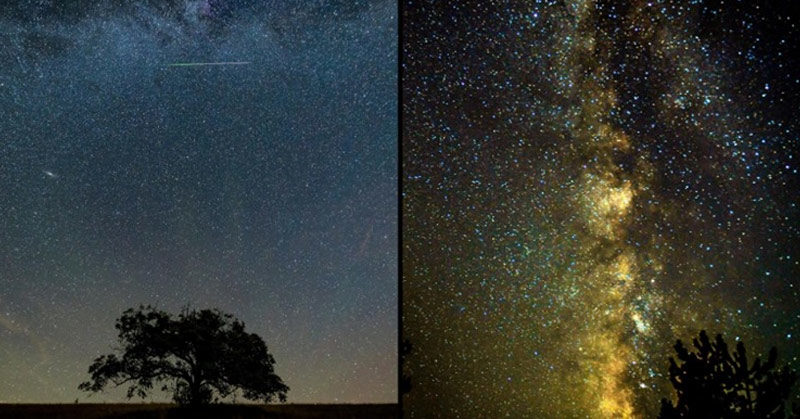In what will likely be any stargazer’s dream, the sky will be filled with dozens of meteors in the next couple of days. “Shooting stars” are not so easy to catch but if you can stay up during the three-day window, you’ll get to see some. Get ready for this year’s Perseid meteor shower.

A meteor shower is an astronomical event that occurs when a large number of meteors flash across the night sky seemingly from the same point [1]. The Perseids meteor shower is amongst the brightest of them. Everywhere in the world – especially in the northern hemisphere, the Perseid meteors come out in large numbers during the summer nights. This year, they are expected to be at their biggest and brightest in the early hours of August 11, 12, and 13. This gives you a 3-day window to catch these “diamonds in the sky” [2].
Origin of the name, Perseids
Meteor showers derive their names from the constellations they originate from. This constellation is known as a radiant. The radiant point for the Perseid meteor (when you trace it backward) is the constellation Perseus, which means the Hero.

You’d typically find this constellation in the northern sky, but for the meteor showers, you can find them anywhere in the night sky [3].
What causes the Perseid meteor shower?
Meteors are meteoroids (small pieces of asteroids or comets) that become vaporized into streaks of light when they enter the Earth’s atmosphere [4]. The Perseid meteors are birthed from the Comet Swift-Tuttle. This comet, with an impressive 16-mile wide nucleus, is the largest object from the solar system to pass by the earth repeatedly, according to NASA. “Repeatedly” might be a bit of a stretch here. In reality, it passes by once every 133 years. This means that it was last seen in 1992, and the next appearance will occur in 2126.
However, the Perseid meteor shower would certainly leave a long-lasting impression. Every year, as the earth passes through the dust and debris left behind by the Comet Swift-Tuttle, the Perseid meteor shower occurs [5].

If you think about it, Perseids are the actual definition of shooting stars as they cut across the sky with speeds as high as 37 miles per second. They’re also almost as bright as Jupiter or Venus, causing them to be nicknamed the “Fireball champion of meteors” by NASA meteor expert, Bill Cooke [6].
The Perseids also boasts of over 50 meteors passing through the sky in an hour. In some years, over 100 meteors have been counted flittering past the sky in one hour. Sadly, 2020 is not one of them, although we can expect a bit more than was seen in 2019 [7].
Read: Photographer ‘Accidentally’ Captures Incredible Photos of a Brilliant Green Meteor
Here’s why the moonlight will put a bit of a damper on this year’s Perseid meteor shower
Ideally, a meteor shower is best seen with low light. As the Perseid meteor shower gets into its peak moments, the August Moon will be slightly over its last quarter stage. Consequently, the brightness of the moon will make it a bit harder for you to see the shooting stars in all their glory. Despite this development, the shower will still be visible to the unaided eye. You just need to find a dark or poorly-lit location between late night and early morning of the 3 peak days.
According to Amie Gallagher, Director of the Planetarium at Raritan Valley Community College, Somerset County, “The best time to see any meteor shower is after midnight. That’s when the part of the earth that you are on is moving into the stream of meteors.”
This is better than last year’s Perseid shower when the moon was very close to its full phase, making the whole shower a lot harder to see[8].
How to enjoy the celestial show

The Perseid meteor shower is quite easy to view. You don’t need to go to a planetarium or use any fancy equipment. The most important factor is to find a part of your city or town with very light pollution of light. If you’re lucky, your home would be situated in a perfect area and all you need to do is stay up or wake at the right time.
If you have to leave your comfort zone, make sure the location is safe, and it’s best to go with a group of people. You may need to pack a few essentials. Also, your eyes need time to adjust to the darkness – about 30 minutes – and you will have to spend up to an hour to see a reasonable number of the meteors, so it’s best to go with a seat or mat for your comfort [9]. Depending on the climate, you may have to wear something warm as it’s usually chilly that early in the morning.
Finally, don’t forget snacks, bugs spray, and your favorite playlist. Truly, there’s something therapeutic about listening to music while staring up at a sky full of shooting stars. Regardless of what you choose to wear or take with you, just go outside for the show, and don’t forget to make a wish…or 50 wishes, after all, there will be enough shooting stars willing to pick them up.
Check out this interactive map to show how Earth passes through the meteor shower!
- Meteor Shower Calendar. Time and Date. https://www.timeanddate.com/astronomy/meteor-shower/list.html. Retrieved 09-08-2020.
- Maddie Capron You could see 100 meteors an hour zoom by next week. Here’s how to catch the Perseids. The News Tribune.. https://www.thenewstribune.com/news/nation-world/national/article244780307.html. Retrieved 09-08-2020.
- Nicole Mortillaro. Annual Perseid meteor shower peaks this week: How you can catch some ‘shooting stars’. CBC. https://www.cbc.ca/news/technology/perseids-2020-1.5678617. Retrieved 09-08-2020.
- Asteroid or Meteor: What’s the Difference? Space Place. https://spaceplace.nasa.gov/asteroid-or-meteor/en/. Retrieved 09-08-2020.
- Sarah Lewin. Comet Swift-Tuttle: The Icy Parent of the Perseid Meteor Shower. Space. https://www.space.com/33677-comet-swift-tuttle-perseid-meteor-shower-source.html. Retrieved 09-08-2020.
- Marlene Lang. Perseid Meteor Shower: Peak Dates For ‘Fireballs’ Over PA Skies. Patch. https://patch.com/pennsylvania/westchester/perseid-meteor-shower-known-fireball-champion-happening-now?utm_source=newsstand&utm_medium=rss&utm_term=weather&utm_campaign=recirc&utm_content=newsstand. Retrieved 09-08-2020.
- Eric Mack. The 2020 Perseid meteor shower peaks soon: How to watch the show. CNET. https://www.cnet.com/how-to/2020-perseid-meteor-shower-peaks-sasteroid-or-meteoroon-how-to-catch-the-show/. Retrieved 09-08-2020.
- Evan Slavit and Len Melisurgo. Perseid meteor shower 2020: When and where to see the best fireballs in the sky this summer. NJ. https://www.nj.com/news/2020/08/perseid-meteor-shower-2020-when-and-where-to-see-the-best-fireballs-in-the-sky-this-summer.html. Retrieved 09-08-2020.
- Sarah Lewin. Perseid meteor shower 2020: When, where & how to see it. Space. https://www.space.com/32868-perseid-meteor-shower-guide.html. Retrieved 09-08-2020.

